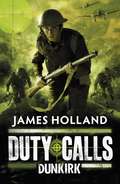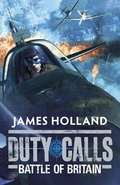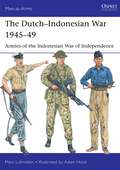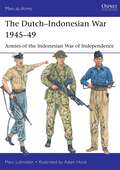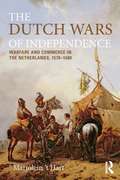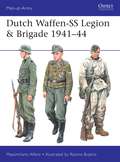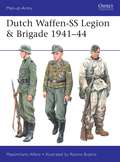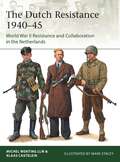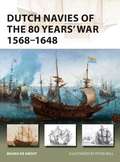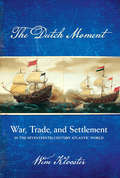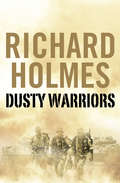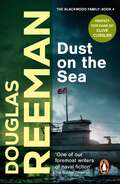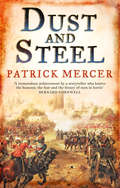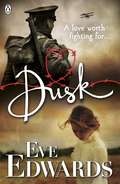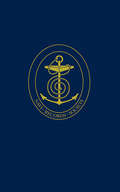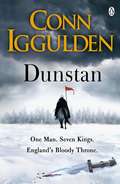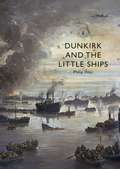- Table View
- List View
Duty Calls: Dunkirk (Duty Calls)
by James Holland'YOU WANTED TO SEE SOME ACTION - WELL YOU'RE GOING TO GET IT NOW. YOU'RE GOING TO GET IT NOW ALL RIGHT.'Friday 24th May, 1940Private Johnny Hawke, aged sixteen, awakens to artillery fire.Hours later, Stukas scream down from the sky. Messerschmit fighters roar towards his regiment. Trucks burst into flames.Now men and mules lay dead and dying, severed limbs twisted grotesquely as blood soaks the cobbled streets.Young Private Hawke just wants to do his duty and serve his country. But as he - and his fellow soldiers - prepare to stop the German advance, there's only one question on everyone's lips.HOW WILL THEY SURVIVE?
Duty Calls: World War 2 Fiction (Duty Calls)
by James HollandPilot officer Archie Jackson, 19, is in control of the RAF's newest fighter aircraft, a Supermarine Spitfire.Now he has the Luftwaffe in his sights and only one thing matters: defending Britain. Suddenly planes are falling from the sky, exploding and spiralling into the English Channel.France has fallen and the swastika flies over Occupied Europe. Only these young pilots - barely out of boyhood - stand between Britain and a Nazi invasion . . . Duty Calls: Battle of Britain, throws you deep into the heart - and horror - of Britain's darkest, and finest, hour.** Historian James Holland is the bestselling author of the Jack Tanner adult war fiction books. Duty Calls is his first series for younger readers, and showcases his expertise on the Second World War. ** James Holland presented Battle of Britain: The Real Story on BBC2.
The Dutch–Indonesian War 1945–49: Armies of the Indonesian War of Independence (Men-at-Arms)
by Marc LohnsteinHighly detailed and colourful, this account illustrates the struggle of Indonesian forces in their War of Independence against the Netherlands, following the surrender of occupying Japanese forces in 1945.Following on from MAA 521 Royal Netherlands East Indies Army 1936–42 and completing the coverage of the post-World War II wars of decolonization, The Dutch–Indonesian War 1945–49 describes the Japanese surrender in September 1945 which left a power vacuum in the colonial Dutch East Indies (Indonesia). Using vivid colour illustrations and rare photos, this title depicts the various forces involved in the struggle for Indonesia: the British Indian Army troops sent to key areas to disarm Japanese garrisons, the Indonesian nationalists who immediately proclaimed an independent Republic, remaining Japanese troops, and the Dutch forces which arrived in 1946.The wide dispersion of populations, and their ethnic, religious and political differences ensured that the struggle which followed was complex. Fragmented bands of nationalist permuda insurgents were slowly brought together under command of a republican army (the BKR, later TKR, and finally the TNI, complete with naval and air elements), but stubborn negotiations alternated with bouts of major fighting. This book details how the nationalists were defeated by Dutch and Dutch-led local forces in urban areas (e.g. during Operations Product and Crow, 1947 and 1948), but how their guerrillas evaded Dutch troops in the jungle hills and swamps. Illustrating a wide range of uniforms, insignia, personal weapons and equipment, this study showcases the troops and armour involved in the conflict.
The Dutch–Indonesian War 1945–49: Armies of the Indonesian War of Independence (Men-at-Arms)
by Marc LohnsteinHighly detailed and colourful, this account illustrates the struggle of Indonesian forces in their War of Independence against the Netherlands, following the surrender of occupying Japanese forces in 1945.Following on from MAA 521 Royal Netherlands East Indies Army 1936–42 and completing the coverage of the post-World War II wars of decolonization, The Dutch–Indonesian War 1945–49 describes the Japanese surrender in September 1945 which left a power vacuum in the colonial Dutch East Indies (Indonesia). Using vivid colour illustrations and rare photos, this title depicts the various forces involved in the struggle for Indonesia: the British Indian Army troops sent to key areas to disarm Japanese garrisons, the Indonesian nationalists who immediately proclaimed an independent Republic, remaining Japanese troops, and the Dutch forces which arrived in 1946.The wide dispersion of populations, and their ethnic, religious and political differences ensured that the struggle which followed was complex. Fragmented bands of nationalist permuda insurgents were slowly brought together under command of a republican army (the BKR, later TKR, and finally the TNI, complete with naval and air elements), but stubborn negotiations alternated with bouts of major fighting. This book details how the nationalists were defeated by Dutch and Dutch-led local forces in urban areas (e.g. during Operations Product and Crow, 1947 and 1948), but how their guerrillas evaded Dutch troops in the jungle hills and swamps. Illustrating a wide range of uniforms, insignia, personal weapons and equipment, this study showcases the troops and armour involved in the conflict.
The Dutch Wars of Independence: Warfare and Commerce in the Netherlands 1570-1680 (Modern Wars In Perspective)
by Marjolein 't HartIn The Dutch Wars of Independence, Marjolein ’t Hart assesses the success of the Dutch in establishing their independence through their eighty years struggle with Spain - one of the most remarkable achievements of the sixteenth and seventeenth centuries. Other rebellions troubled mighty powers of this epoch, but none resulted in the establishment of an independent, republican state. This book: tells the story of the Eighty Years War and its aftermath, including the three Anglo-Dutch Wars and the Guerre de Hollande (1570-1680). explores the interrelation between war, economy and society, explaining how the Dutch could turn their wars into commercial successes. illustrates how war could trigger and sustain innovations in the field of economy and state formation ; the new ways of organization of Dutch military institutions favoured a high degree of commercialized warfare. shows how other state rulers tried to copy the Dutch way of commercialized warfare, in particular in taking up the protection for capital accumulation. As such, the book unravels one of the unknown pillars of European state formation (and of capitalism). The volume investigates thoroughly the economic profitability of warfare in the early modern period and shows how smaller, commercialized states could sustain prolonged war violence common to that period. It moves beyond traditional explanations of Dutch success in warfare focusing on geography, religion, diplomacy while presenting an up-to-date overview and interpretation of the Dutch Revolt, the Anglo-Dutch Wars and the Guerre de Hollande.
The Dutch Wars of Independence: Warfare and Commerce in the Netherlands 1570-1680 (Modern Wars In Perspective)
by Marjolein 't HartIn The Dutch Wars of Independence, Marjolein ’t Hart assesses the success of the Dutch in establishing their independence through their eighty years struggle with Spain - one of the most remarkable achievements of the sixteenth and seventeenth centuries. Other rebellions troubled mighty powers of this epoch, but none resulted in the establishment of an independent, republican state. This book: tells the story of the Eighty Years War and its aftermath, including the three Anglo-Dutch Wars and the Guerre de Hollande (1570-1680). explores the interrelation between war, economy and society, explaining how the Dutch could turn their wars into commercial successes. illustrates how war could trigger and sustain innovations in the field of economy and state formation ; the new ways of organization of Dutch military institutions favoured a high degree of commercialized warfare. shows how other state rulers tried to copy the Dutch way of commercialized warfare, in particular in taking up the protection for capital accumulation. As such, the book unravels one of the unknown pillars of European state formation (and of capitalism). The volume investigates thoroughly the economic profitability of warfare in the early modern period and shows how smaller, commercialized states could sustain prolonged war violence common to that period. It moves beyond traditional explanations of Dutch success in warfare focusing on geography, religion, diplomacy while presenting an up-to-date overview and interpretation of the Dutch Revolt, the Anglo-Dutch Wars and the Guerre de Hollande.
Dutch Waffen-SS Legion & Brigade 1941–44 (Men-at-Arms)
by Massimiliano AfieroGoebbels' 1941 propaganda campaign to present Germany's invasion of the USSR as a battle for European civilization against Asian barbarism convinced many men in occupied 'Germanic' European countries, such as Scandinavia and the Low Countries, to volunteer to fight on the Russian Front. One of the strongest national legions of such a kind was raised in the Netherlands, where it was supported by a large pro-Nazi movement led by Anton Mussert. The 3,000-man Netherlands Volunteer Legion fought on the Leningrad front in regimental strength, from the Red Army's winter 1941/42 counter-offensive until April 1943. The survivors were then reinforced to form a 5,500-strong Panzergrenadier Brigade, and after anti-partisan service in Croatia, they returned to Army Group North as part of Steiner's III SS Panzer Korps, fighting in the most arduous battles of 1943–44 until driven back into Pomerania. In the final months of the war the division formed the nucleus of the new 23rd SS Volunteer Panzergrenadier Division 'Nederland'.In this illustrated study of the Dutch Waffen-SS Legion and Brigade, specialist Massimiliano Afiero explores the full history of this important formation from its establishment in 1941 until it was incorporated into the 'Nederland' Division in 1944. Contemporary photographs and full-colour illustrations support the text and reveal key details including aspects of uniform and insignia.
Dutch Waffen-SS Legion & Brigade 1941–44 (Men-at-Arms)
by Massimiliano AfieroGoebbels' 1941 propaganda campaign to present Germany's invasion of the USSR as a battle for European civilization against Asian barbarism convinced many men in occupied 'Germanic' European countries, such as Scandinavia and the Low Countries, to volunteer to fight on the Russian Front. One of the strongest national legions of such a kind was raised in the Netherlands, where it was supported by a large pro-Nazi movement led by Anton Mussert. The 3,000-man Netherlands Volunteer Legion fought on the Leningrad front in regimental strength, from the Red Army's winter 1941/42 counter-offensive until April 1943. The survivors were then reinforced to form a 5,500-strong Panzergrenadier Brigade, and after anti-partisan service in Croatia, they returned to Army Group North as part of Steiner's III SS Panzer Korps, fighting in the most arduous battles of 1943–44 until driven back into Pomerania. In the final months of the war the division formed the nucleus of the new 23rd SS Volunteer Panzergrenadier Division 'Nederland'.In this illustrated study of the Dutch Waffen-SS Legion and Brigade, specialist Massimiliano Afiero explores the full history of this important formation from its establishment in 1941 until it was incorporated into the 'Nederland' Division in 1944. Contemporary photographs and full-colour illustrations support the text and reveal key details including aspects of uniform and insignia.
The Dutch Resistance 1940–45: World War II Resistance and Collaboration in the Netherlands (Elite)
by Klaas Castelein Michel WentingDescribes and illustrates the full range of Dutch resistance groups and German and collaborationist counter-resistance groups during the Nazi occupation in 1940-45.The Nazi occupation of the Netherlands in World War II followed a complex course, whose scope is not widely understood. It was a great deal broader and more varied than the much-reported German counter-espionage success against Dutch agents parachuted in by the Special Operations Executive. From spring 1943 onwards, three Dutch Resistance organizations gained momentum: the Order Service (OD), the Resistance Council (RVV), and the National Assault Teams (LKP). In response, the Germans raised collaborationist forces to counter the Resistance, including the much-feared Landwacht. In September 1944 the OD, RVV and LKP amalgamated into the Netherlands Interior Forces (NBS), while Allied troops began to liberate the southern provinces. This allowed NBS forces in the south to form Stoottroepen, uniformed and armed by both the British and US armies. These assisted the Allied advance, while a bloody underground struggle continued in the occupied north until final liberation in April–May 1945. Illustrated with rare photos and new colour plates, this book gives a comprehensive account of one of the lesser-known struggles of World War II.
The Dutch Resistance 1940–45: World War II Resistance and Collaboration in the Netherlands (Elite)
by Klaas Castelein Michel WentingDescribes and illustrates the full range of Dutch resistance groups and German and collaborationist counter-resistance groups during the Nazi occupation in 1940-45.The Nazi occupation of the Netherlands in World War II followed a complex course, whose scope is not widely understood. It was a great deal broader and more varied than the much-reported German counter-espionage success against Dutch agents parachuted in by the Special Operations Executive. From spring 1943 onwards, three Dutch Resistance organizations gained momentum: the Order Service (OD), the Resistance Council (RVV), and the National Assault Teams (LKP). In response, the Germans raised collaborationist forces to counter the Resistance, including the much-feared Landwacht. In September 1944 the OD, RVV and LKP amalgamated into the Netherlands Interior Forces (NBS), while Allied troops began to liberate the southern provinces. This allowed NBS forces in the south to form Stoottroepen, uniformed and armed by both the British and US armies. These assisted the Allied advance, while a bloody underground struggle continued in the occupied north until final liberation in April–May 1945. Illustrated with rare photos and new colour plates, this book gives a comprehensive account of one of the lesser-known struggles of World War II.
Dutch Navies of the 80 Years' War 1568–1648 (New Vanguard)
by Peter Bull Bouko De GrootThe tiny new state of the United Provinces of the Netherlands won its independence from the mighty Spanish empire by fighting and winning the Eighty Years' War, from 1568 and 1648. In this long conflict, warfare on water played a much bigger role in determining the ultimate victor. On the high seas the fleet carved out a new empire, growing national income to such levels that it could continue the costly war for independence. Yet it was in coastal and inland waters that the most decisive battles were fought. Arguably the most decisive Spanish siege (Leiden, 1574) was broken by a fleet sailing to the rescue across flooded polders, and the battle of Nieuwpoort in 1600, the largest successful invasion fleet before World War II, was one of the most decisive battle in western history. Using detailed full colour artwork, this book shows how the Dutch navies fought worldwide in their war of independence, from Brazil to Indonesia, and from the Low Countries to Angola.
Dutch Navies of the 80 Years' War 1568–1648 (New Vanguard)
by Peter Bull Bouko De GrootThe tiny new state of the United Provinces of the Netherlands won its independence from the mighty Spanish empire by fighting and winning the Eighty Years' War, from 1568 and 1648. In this long conflict, warfare on water played a much bigger role in determining the ultimate victor. On the high seas the fleet carved out a new empire, growing national income to such levels that it could continue the costly war for independence. Yet it was in coastal and inland waters that the most decisive battles were fought. Arguably the most decisive Spanish siege (Leiden, 1574) was broken by a fleet sailing to the rescue across flooded polders, and the battle of Nieuwpoort in 1600, the largest successful invasion fleet before World War II, was one of the most decisive battle in western history. Using detailed full colour artwork, this book shows how the Dutch navies fought worldwide in their war of independence, from Brazil to Indonesia, and from the Low Countries to Angola.
The Dutch Moment: War, Trade, and Settlement in the Seventeenth-Century Atlantic World
by Wim KloosterIn The Dutch Moment, Wim Klooster shows how the Dutch built and eventually lost an Atlantic empire that stretched from the homeland in the United Provinces to the Hudson River and from Brazil and the Caribbean to the African Gold Coast. The fleets and armies that fought for the Dutch in the decades-long war against Spain included numerous foreigners, largely drawn from countries in northwestern Europe. Likewise, many settlers of Dutch colonies were born in other parts of Europe or the New World. The Dutch would not have been able to achieve military victories without the native alliances they carefully cultivated. Indeed, the Dutch Atlantic was quintessentially interimperial, multinational, and multiracial. At the same time, it was an empire entirely designed to benefit the United Provinces. The pivotal colony in the Dutch Atlantic was Brazil, half of which was conquered by the Dutch West India Company. Its brief lifespan notwithstanding, Dutch Brazil (1630–1654) had a lasting impact on the Atlantic world. The scope of Dutch warfare in Brazil is hard to overestimate—this was the largest interimperial conflict of the seventeenth-century Atlantic. Brazil launched the Dutch into the transatlantic slave trade, a business they soon dominated. At the same time, Dutch Brazil paved the way for a Jewish life in freedom in the Americas after the first American synagogues opened their doors in Recife. In the end, the entire colony eventually reverted to Portuguese rule, in part because Dutch soldiers, plagued by perennial poverty, famine, and misery, refused to take up arms. As they did elsewhere, the Dutch lost a crucial colony because of the empire’s systematic neglect of the very soldiers on whom its defenses rested.After the loss of Brazil and, ten years later, New Netherland, the Dutch scaled back their political ambitions in the Atlantic world. Their American colonies barely survived wars with England and France. As the imperial dimension waned, the interimperial dimension gained strength. Dutch commerce with residents of foreign empires thrived in a process of constant adaptation to foreign settlers’ needs and mercantilist obstacles.
Dusty Warriors (Text Only): Modern Soldiers At War (text Only)
by Richard HolmesForemost military historian Richard Holmes offers us a compelling and at times terrifying account of what it means to be a contemporary soldier.
The Dust that Falls from Dreams
by Louis De BernieresA return to the epic romance, heroism, history and warm and eccentric cast of characters that made CAPTAIN CORELLI'S MANDOLIN such an extraordinary hit (2.5 million copies sold).In the brief golden years before the outbreak of World War I, Rosie McCosh and her three very different sisters are growing up in an eccentric household in Kent, with their neighbours the Pitt boys on one side and the Pendennis boys on the other. But their days of childhood adventure are shadowed by the approach of the conflict that will engulf them on the cusp of adulthood.When the boys end up scattered along the Western Front, Rosie is left confused by her love for two young men - one an infantry soldier and one a flying ace. Can she, and her sisters, build new lives out of the opportunities and devastations that follow the Great War?
Dust On The Sea: an all-action, edge-of-your-seat naval adventure from the master storyteller of the sea (The\royal Marines Ser. #4)
by Douglas ReemanIt is 1943, and Captain Mike Blackwood, Royal Marine Commando, is a survivor. Young, toughened and tried in the hellish crucible of Burma, he labours, sometimes faltering, beneath the weight of tradition, the glorious heritage of his family, and the burden of his own self-doubt. For Blackwood, the horizon is not the lip of the trench seen by men of the Corps in the previous war, but the ramp of a landing craft smashing down into the sea, and the fire of the enemy on a Sicilian beach. Here, tradition is not enough, and Mike Blackwood must find within himself qualities of leadership which will inspire those Royal Marines who are once again the first to land, and among the first to die. This is the fourth novel in the Blackwood saga, spanning 150 years in the history of a great seafaring family and the tradition in which they served.
Dust Clouds of War (Simon Fonthill #12)
by John WilcoxSeptember, 1914. The First World War has already broken out on the Western Front. Thousands of miles away, on the border between Northern Rhodesia and German East Africa, Simon Fonthill is preparing for battle alongside his faithful companion ‘352’ Jenkins and his reliable tracker, Mzingeli.As they negotiate their way across foreign lands and hostile territories, the Magnificent Trio come under constant fire from enemy forces and at the bequest of Admiral Herbert King-Hall, they undertake their most dangerous mission yet. Sinking the Königsberg, a German cruiser ship hidden deep in the Rufiji Delta in German occupied waters, will test the trio’s nerve, courage and determination to the limit.Meanwhile, Fonthill’s wife Alice has been conducting investigations of her own in Mombasa – and when she thinks something is amiss within the camp, she takes matters into her own hands. Amidst the chaos of war, treachery is never far away . . .
Dust and Steel
by Patrick MercerThrilling military history from the author of To Do and Die. Perfect for fans of Andy McNabb and Richard Sharpe.
Dusk
by Eve EdwardsDusk by Eve Edwards is a beautiful love story set against the brutal back drop of WWI.For all fans of Sebastian Faulks and historical fiction - this is Bird Song for young adult readers.A love worth fighting for.When Helen, a young hard-working nurse, meets aristocratic artist Sebastian, she doesn't expect to even like him, let alone fall in love. But against the troubled backdrop of wartime London, an unlikely but intense romance blossoms. And even the bloody trenches of the Somme, where they are both posted, cannot diminish their feelings for each other.But Helen is concealing a secret and when a terrible crime is committed there are devastating consequences for them both.When lives are being lost, can true love survive?Eve Edwards is an award-winning author. She lives in Oxford and is married with three children.www.eve-edwards.com
The Durham Papers: Selections from the Papers of Admiral Sir Philip Charles Henderson Calderwood Durham G.C.B. (1763-1845) (Navy Records Society Publications)
by Hilary L. RubinsteinAdmiral Sir Philip Durham (1763–1845) was one of the most distinguished and colourful officers of the late Georgian Navy. His lucky and sometimes controversial career included surviving the sinking of HMS Royal George in 1782, making the first conquest of the tricolour flag in 1793 and the last in 1815, and having two enemy ships surrender to him at Trafalgar. A Scot distantly related to Lord Barham, Durham entered the Navy in 1777, serving initially on the American and West Indies stations. He was Kempenfelt's signal officer on HMS Victory during the second battle of Ushant in 1781 and on the Royal George. Making his reputation initially as the daring young master and commander of HMS Spitfire early in the French Revolutionary War, he became a crack frigate captain with a fortune in prize money, and commanded HMS Defiance at Trafalgar, where he was wounded. He ended his war service as Commander-in-Chief, Leeward Islands. En voyage he artfully captured two brand-new French frigates which were subsequently taken into the service of Britain, and during his tenure he won the heartfelt gratitude of local merchants by ridding the surrounding seas of American privateers preying on British trading vessels. True to form, he clashed with the judge of the Vice-Admiralty Court on Antigua and with the general with whom he led a combined naval and military assault on Martinique and Guadeloupe following Napoleon's escape from Elba. He later served as Commander-in-Chief, Portsmouth having resigned his parliamentary seat to do so. Married first to the sister of the Earl of Elgin, of 'Marbles' fame, and secondly to a cousin of 'sea wolf' Lord Cochrane, he was well-known to George III, who as a result of Durham's amusing yet improbable anecdotes, dubbed any tall tale he heard 'a Durham'. This collection of his papers consists mainly of letters and despatches relating to his service in the Channel Fleet, the Mediterranean, and the Leeward Islands. Correspondence with his parents during 1789–1790 reflects his anxieties relating to employment and prospects for promotion when he was a young lieutenant with an illegitimate child to support. The collection, featuring items from and to him, comprises a fascinating and informative set of documents.
The Durham Papers: Selections from the Papers of Admiral Sir Philip Charles Henderson Calderwood Durham G.C.B. (1763-1845) (Navy Records Society Publications #166)
by Hilary L. RubinsteinAdmiral Sir Philip Durham (1763–1845) was one of the most distinguished and colourful officers of the late Georgian Navy. His lucky and sometimes controversial career included surviving the sinking of HMS Royal George in 1782, making the first conquest of the tricolour flag in 1793 and the last in 1815, and having two enemy ships surrender to him at Trafalgar. A Scot distantly related to Lord Barham, Durham entered the Navy in 1777, serving initially on the American and West Indies stations. He was Kempenfelt's signal officer on HMS Victory during the second battle of Ushant in 1781 and on the Royal George. Making his reputation initially as the daring young master and commander of HMS Spitfire early in the French Revolutionary War, he became a crack frigate captain with a fortune in prize money, and commanded HMS Defiance at Trafalgar, where he was wounded. He ended his war service as Commander-in-Chief, Leeward Islands. En voyage he artfully captured two brand-new French frigates which were subsequently taken into the service of Britain, and during his tenure he won the heartfelt gratitude of local merchants by ridding the surrounding seas of American privateers preying on British trading vessels. True to form, he clashed with the judge of the Vice-Admiralty Court on Antigua and with the general with whom he led a combined naval and military assault on Martinique and Guadeloupe following Napoleon's escape from Elba. He later served as Commander-in-Chief, Portsmouth having resigned his parliamentary seat to do so. Married first to the sister of the Earl of Elgin, of 'Marbles' fame, and secondly to a cousin of 'sea wolf' Lord Cochrane, he was well-known to George III, who as a result of Durham's amusing yet improbable anecdotes, dubbed any tall tale he heard 'a Durham'. This collection of his papers consists mainly of letters and despatches relating to his service in the Channel Fleet, the Mediterranean, and the Leeward Islands. Correspondence with his parents during 1789–1790 reflects his anxieties relating to employment and prospects for promotion when he was a young lieutenant with an illegitimate child to support. The collection, featuring items from and to him, comprises a fascinating and informative set of documents.
Dunstan: One Man. Seven Kings. England's Bloody Throne.
by Conn IgguldenOne man. Seven Kings. England's bloody throne. 'Iggulden tells an absolutely cracking story. The pace is nail-biting and the set dressing magnificent' The TimesTenth century England: a divided and broken country of misrule. Yet King Athelstan, grandson of Alfred the Great, seeks to unite the kingdom under one crown. By his side is Dunstan of Glastonbury - priest, soldier, visionary and, some insist, traitor - whose task is to steward seven kings through fire, war, murder and fury to see Athelstan's dream come true. But what stain will it leave on his mortal soul?'Iggulden has created an intriguingly complex saint - flawed, spiteful and unreliable as the teller of his own tale. Through his eyes we watch the story of the making of England' The Times'Engrossing. Rich in intrigue, with Iggulden breathing life into this remarkable and complex figure who played a vital role in safeguarding a newly united England' Daily Express'A gripping and glorious legend. Brilliant!' Weekend Sport'Breathes new life into the darkest and most dramatic of times' Star'Dunstan is a vivid, convincing character' BBC History Magazine
Dunkirk and the Little Ships (Shire Library #867)
by Philip WeirIn May 1940, German troops advanced through Holland, Belgium and France with astonishing speed, forcing the British Expeditionary Force and the French army to retreat to the north-east coast of France. The evacuation plan – Operation Dynamo – was put into effect with the expectation that only about 45,000 men might be rescued. However, by the hasty assembly of a vast armada of disparate vessels (thought to be in the region of 900, of which about 700 were privately owned), 338,226 Allied troops were brought safely back to England. Without the contribution of those Dunkirk Little Ships, as they have come to be known, thousands of British troops would have died on the shores of France, and the ongoing fight against the Axis powers rendered all the more challenging. In this title, Philip Weir reveals the story of all the vessels that undertook such a great mission, exploring their general role and individual histories, including their preservation and the Little Ships participation in return runs every five years.
Dunkirk and the Little Ships (Shire Library)
by Philip WeirIn May 1940, German troops advanced through Holland, Belgium and France with astonishing speed, forcing the British Expeditionary Force and the French army to retreat to the north-east coast of France. The evacuation plan – Operation Dynamo – was put into effect with the expectation that only about 45,000 men might be rescued. However, by the hasty assembly of a vast armada of disparate vessels (thought to be in the region of 900, of which about 700 were privately owned), 338,226 Allied troops were brought safely back to England. Without the contribution of those Dunkirk Little Ships, as they have come to be known, thousands of British troops would have died on the shores of France, and the ongoing fight against the Axis powers rendered all the more challenging. In this title, Philip Weir reveals the story of all the vessels that undertook such a great mission, exploring their general role and individual histories, including their preservation and the Little Ships participation in return runs every five years.
Dunkirk
by A.D. Divine O.B.E.This is the story of Dunkirk and of the men who planned it (insofar as it was planned) and of the men who carried it out, and of their ships. Mr Divine, who was himself with the small boats, writes with the authority of direct knowledge. He had the assistance of the men who were intimately concerned with planning and organising the operation. This is the true story of Dunkirk from its almost nebulous beginnings to the astonishing triumph of its end.
